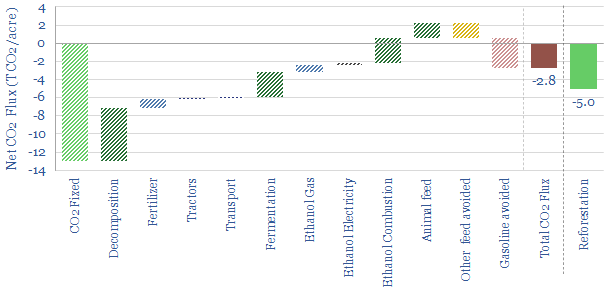30M acres of US croplands are used to grow corn for ethanol. Each acre prevents 2-3 tons of CO2 emissions per annum, for a CO2 abatement cost of $200/ton. However, if these same acres were reforested, they could absorb 2x more CO2, creating a 150MTpa CO2 sink; while at $15-50/ton CO2 prices, farmers in the mid-West could have higher earnings. Hence this 15-page note asks if the rise of carbon removals could re-shape US biofuels?
An overview of the US corn-to-ethanol industry is given on pages 2-4, covering the four main rationales for blending 40% of the corn crop into biofuels. But do these rationales stand up to scrutiny?
An overview of the ethanol production process is given on page 5, as this will be the basis for our economic and carbon modelling.
The economics of ethanol production are presented on page 6. We find the marginal cost of US ethanol is currently c40% higher than the cost of wholesale gasoline.
Carbon accounting is the main focus of this research note, and our numbers are laid out on pages 7-11. Looking category by category, we show that the CO2 prevented per acre of farmland is between 2-3 tons per annum.
Reforesting the same land could avoid 2x more CO2, we find. On pages 12-13 we ask ‘is it feasible?’, ‘is it economical?’ and ‘is there a market?’. We argue “yes” in each case.
Our conclusions are laid out on pages 14-15. The rise of corporate carbon offsetting could re-shape the US biofuels industry, with implications for farmers, the ethanol industry and the US refining industry.
